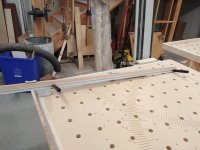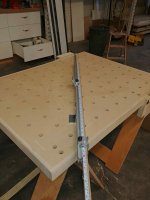I had a lapse in my focused woodworking and after a recent move I now have a dedicated basement work space (12x22) and two MFT 1080s and other assorted Festool's and shop machines (table saw, planer, jointer). It seems my MFT 1080 is out of date, but I still think it is useful and not worth replacing with 2 MFT3's.
I recently had a CNC shop make two new tops for the 1080 tables. However, I am without a fence and after reading here and watching some YOUTUBE videos it seems that during my hiatus from woodworking, there are newer options for repeatable crosscuts, one of my main cutting tasks on the MFT. As I understand the current state of things, here are some of the options for putting a fence for crosscuts on my MFT 1080:
1) Benchdog and some others make a fence that uses dogs to hold the fence in place.
2) Some kind of track butted against dogs and clamped to the table so that it does not move.
3) Use aluminum extrusions like 8020 sells to attach to the the table for a fence.
4) Use a variety of dogs and spacers to set up the table for repeatable cuts, including using rail dogs for the rail.
5) Replace the Festool brackets with the Dashboard brackets and use a Benchdog like fence.
Are there other options? Some folks seem to prefer using a fence rail and others dogs for crosscuts. What is the state of current preferences for upgrading an MFT type table --- in my case a 1080 that does not have the newer edge profiles with the V track -- for repeatable crosscuts?
Thanks ...
I recently had a CNC shop make two new tops for the 1080 tables. However, I am without a fence and after reading here and watching some YOUTUBE videos it seems that during my hiatus from woodworking, there are newer options for repeatable crosscuts, one of my main cutting tasks on the MFT. As I understand the current state of things, here are some of the options for putting a fence for crosscuts on my MFT 1080:
1) Benchdog and some others make a fence that uses dogs to hold the fence in place.
2) Some kind of track butted against dogs and clamped to the table so that it does not move.
3) Use aluminum extrusions like 8020 sells to attach to the the table for a fence.
4) Use a variety of dogs and spacers to set up the table for repeatable cuts, including using rail dogs for the rail.
5) Replace the Festool brackets with the Dashboard brackets and use a Benchdog like fence.
Are there other options? Some folks seem to prefer using a fence rail and others dogs for crosscuts. What is the state of current preferences for upgrading an MFT type table --- in my case a 1080 that does not have the newer edge profiles with the V track -- for repeatable crosscuts?
Thanks ...



